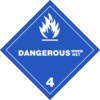×Note:Special provisions may be very complex. The extracts are taken from 49 CFR §172.102. Please be careful with the information, as necessary, additional conditions may be applied that are not written here. Please check the original source and report bugs. | A1 | |
|---|
| A19 | Combination packagings consisting of outer fiber drums or plywood drums, with inner plastic packagings, are not authorized for transportation by aircraft. Browse special provision A19 |
|---|
| B6 | |
|---|
| IB8 | Authorized IBCs: Metal (11A, 11B, 11N, 21A,
21B, 21N, 31A, 31B and 31N); Rigid plastics
(11H1, 11H2, 21H1, 21H2, 31H1 and 31H2 );
Composite (11HZ1, 11HZ2, 21HZ1, 21HZ2 and
31HZ1); Fiberboard (11G); Wooden (11C, 11D
and 11F); Flexible (13H1, 13H2, 13H3, 13H4,
13H5, 13L1, 13L2, 13L3, 13L4, 13M1 or 13M2). Browse special provision IB8 |
|---|
| IP4 | Flexible, fiberboard or wooden IBCs must be
sift-proof and water-resistant or be fitted
with a sift-proof and water-resistant liner. Browse special provision IP4 |
|---|
| IP7 | For UN identification numbers 1327, 1363,
1364, 1365, 1386, 1841, 2211, 2217, 2793 and
3314, IBCs are not required to meet the IBC
performance tests specified in part 178,
subpart N of this subchapter. Browse special provision IP7 |
|---|
| T1 | |
|---|
| TP33 | The portable tank instruction assigned for this substance applies for granular and powdered solids and for solids which are filled and discharged at temperatures above their melting point which are cooled and transported as a solid mass. Solid substances transported or offered for transport above their melting point are authorized for transportation in portable tanks conforming to the provisions of portable tank instruction T4 for solid substances of packing group III or T7 for solid substances of packing group II, unless a tank with more stringent requirements for minimum shell thickness, maximum allowable working pressure, pressure-relief devices or bottom outlets are assigned in which case the more stringent tank instruction and special provisions shall apply. Filling limits must be in accordance with portable tank special provision TP3. Solids meeting the definition of an elevated temperature material must be transported in accordance with the applicable requirements of this subchapter. Browse special provision TP33 |
|---|
| W100 | |
|---|
|
| (10A) Location | A Stowage category “A” means the material may be stowed “on deck” or “under deck” on a cargo vessel or on a passenger vessel. Source: 49 CFR §172.101(k) |
|---|
| (10B) Other | | 13 | Keep as dry as reasonably practicable. | | 40 | Stow “clear of living quarters”. | | 52 | Stow “separated from” acids.1 2 | | 53 | Stow “separated from” alkaline compounds.2 | | 85 | Under deck stowage must be in mechanically ventilated space. | | 103 | Only to be loaded under dry weather conditions. | | 148 | see 49 CFR §176.84 |
1For waste cyanides or waste cyanide mixtures or solutions, refer to §173.12(e) of this subchapter. 2 Class 8 materials in PG II or III that otherwise are required to be segregated from one another may be transported in the same cargo transport unit, whether in the same packaging or not, provided the substances do not react dangerously with each other to cause combustion and/or evolution of considerable heat, or of flammable, toxic or asphyxiant gases, or the formation of corrosive or unstable substances; and the package does not contain more than 30 L (7.8 gallons) for liquids or 30 kg (66 lbs.) for solids. Source: 49 CFR §176.84 |
|---|
|








































